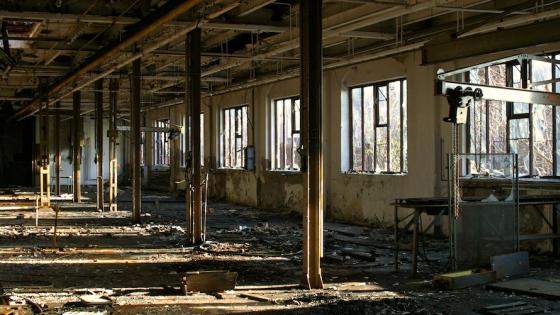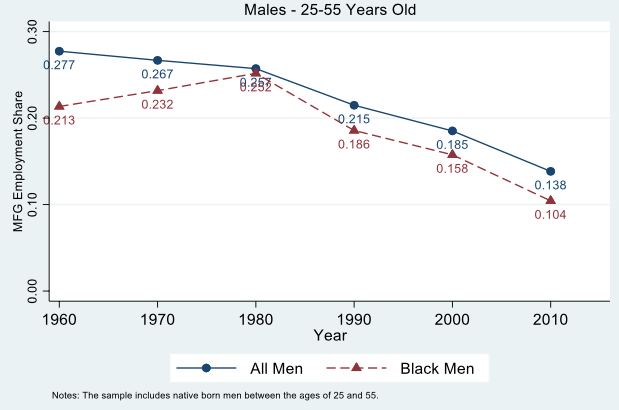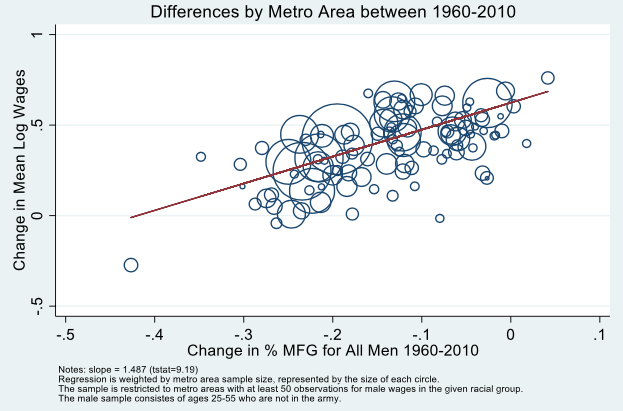Historically, the manufacturing sector provided high-paying jobs to less educated men. During the past 50 years the proportion of workers in this sector has declined dramatically in the US, the UK, and other advanced economies (Figure 1). At the same time, average wage growth has been sluggish or stagnant, particularly for less-educated workers. Their socioeconomic outcomes in terms of marriage, employment, crime, and health have deteriorated.
Figure 1 Employment share in manufacturing, males, 25-55
Source: Gould (2018) using US Census data.
These trends have been even more pronounced for the African American community in the US. This phenomenon is particularly puzzling given the legislative successes of the civil rights movement in the 1960s, and the steady improvement in the education outcomes of blacks relative to whites afterwards. Despite this, the racial gap in wages, employment, and marriage rates has not improved. In many cases, it has widened.
The decline of the manufacturing sector may offer an explanation. A decline in these types of high-paying jobs is bound to have an adverse impact on less-educated workers. Given that the black population is, and has always been, significantly less educated than the white population, this will have a larger effect on blacks relative to whites.
William Julius Wilson (1996) hypothesised that the declining job prospects of black men in the inner cities, is about more than just income and employment. It may have a wider impact on other measures of social organisation like marriage, single parenthood, sexual norms, crime, and health. In particular, Wilson emphasised that the lack of employment opportunities for black men, who disproportionately worked in the manufacturing sector relative to women, may impact black women by reducing their incentives to get married, while increasing their propensity to work, be independent, and have children without getting married first. Therefore the declining opportunity for men in the labour market lowers the socioeconomic outcomes for men, but also has a long-term detrimental impacts on women and children in the most affected labour markets.
The impact of manufacturing decline on black and white Americans
In recent research I investigate how the decline in manufacturing employment affected a broad array of labour market and socio-economic outcomes for men, women, and children (Gould 2018). Since less-educated men benefitted the most from manufacturing jobs, the analysis tests for whether the impact has been greatest for those on the lower end of the education and income distribution, thus leading to greater gaps between those at the top and those at the bottom of the socioeconomic spectrum; in other words, whether it has led to higher inequality.
Wilson's (1996) hypothesis predicts that this decline would also increase the racial gaps in labour market and socioeconomic outcomes. The measures of interest include: wages, employment rates, marriage rates, house values, poverty rates, death rates, single parenthood, teen motherhood, child poverty, and child mortality.
Previous work has linked manufacturing decline to lower employment and wages for black men during the 1970s and 1980s (Bound and Freeman 1992, and Bound and Holzer 1993). Recent work by Autor et al. (2013, 2018) has shown that increased import competition with China caused the manufacturing sector in the US to shrink since 1990, with lower wages, employment, and marriage rates and higher unwed motherhood and poverty.
In my work the analysis covers the past 50 years, so is not limited to the post-1990 period when trade with China began. Most of the trends in the socioeconomic outcomes of blacks and whites, along with the trends in their racial gaps, preceded the era of Chinese trade by many years.
I also analyse outcomes for blacks separately from whites, and therefore test whether the decline in manufacturing jobs affected inequality within and between each racial group. There is no existing study of whether the disappearance of manufacturing work has affected racial gaps. Finally, I examine a broad array of labour market and socioeconomic outcomes for white and black men, women, and children.
This presents evidence that the deterioration for more than 50 years of these outcomes within each racial group, the higher inequality in outcomes within each race, and the growing disparities between racial groups since the early 1970s, have a common cause.
The analysis uses data primarily from the US Census. It exploits geographic variation over time (1960-2010) and space (cities or states) in the US in manufacturing employment along with various socio-economic measures for black and white men, women, and children. Figure 1 shows a 50% drop in employment in this sector from 1960 to 2010.
The decline in manufacturing employment was not uniform across cities. Figure 2 shows that the cities with the largest declines in manufacturing employment experienced the smallest growth in the average wages for black men.
Figure 2 Changes in mean wages for black men, by metro area, 1960-2010
Source: Gould (2018) using US Census data.
A similar pattern exists for the wages of white men (Figure 3), but the impact is lower (a flatter slope) relative to black men.
Figure 3 Changes in mean wages for white men, by metro area, 1960-2010
Source: Gould (2018) using US Census data.
Cities with the largest declines in manufacturing experienced not only the lowest wage growth for white and black men, but also an increase in the racial wage gap. Similar patterns exist for socioeconomic outcomes like marriage rates, employment rates, mortality rates, poverty, house prices, and single motherhood.
A causal interpretation of these results is supported by showing that these findings are robust when I include all Census years from 1960 to 2010 in the sample, control for changes in the demographic composition at the city level or changes in the specification, and when I control for the share of workers in services or unions at the city or state level. Also, because I examined many outcomes and showed a consistent pattern across them, the overall findings and conclusions are unlikely to be due to measurement issues.
Main findings
Looking at all the outcomes of interest, the results show that the decline in manufacturing from 1960 to 2010 had the following impact on the black community:
- a 13.3% decline in black male wages,
- a 5.6 percentage point decline in black male employment rates,
- a marriage rate decline of 4.6 percentage points for black men, and 5.1 percentage points for black women,
- an increase of the poverty rate of 8.0 percentage points for black women,
- a 9 percentage point increase in poverty for black children, and
- a 4 percentage point increase in the chances of living in a single-parent household for black children.
- One-third of the increase in wage inequality among black men is due to manufacturing decline.
The manufacturing trend had the following impact on racial gaps:
- a 12% increase in the racial wage gap for men,
- a 3.4 percentage point increase in the racial gap in male employment,
- a 4.5 percentage point increase in the racial gap in marriage rates for men,
- a 5.0 percentage point increase in the racial gap in marriage rates for women,
- an 8.0 percentage point increase in the racial gap in female poverty,
- a 5.4 percentage point increase in the racial gap in child poverty, and
- a 3.1 percentage point increase in the racial gap of children living with only one parent.
There are similar results for housing prices, home ownership rates, adult mortality before the age of 65, child mortality, and welfare recipiency.
A significant deterioration
The disappearance of high-paying jobs in the manufacturing sector in the past 50 years represents a significant deterioration in the job prospects of less-educated men. The evidence shows that this phenomenon caused a significant decline in the socio-economic outcomes for whites and blacks. There has been increased inequality in outcomes within the white and black communities between the educated and the less educated.
This pattern extends across racial groups – the disappearance of well-paying jobs for less educated workers affected blacks much more than whites – increasing racial gaps across many socioeconomic measures.
This is consistent with the hypothesis that the loss of high paying jobs for relatively less-educated men can have wide-ranging repercussions on outcomes not directly related to the labour market – such as marriage rates, single parenthood, house values, poverty rates for adults and children, mortality rates for adults, and even mortality rates for children.
Overall, this analysis provides the first common link behind some of the major trends taking place over the past 50 years – the stagnation of average wages, higher inequality within racial groups, and the widening racial gaps in income, employment, health, marriage, and family formation. These effects may not be limited to this generation, because by altering the family structure and other childhood conditions, the loss of manufacturing work may also impact the decisions regarding work, education, marriage, crime, and fertility that this generation's children will make.
References
Autor, D H, D Dorn, and G H Hanson (2013), "The China Syndrome: Local Labor Market Effects of Import Competition in the United States", American Economic Review, 103(6): 2121-68.
Autor, D H, D Dorn, and G H Hanson (2018), “When Work Disappears: Manufacturing Decline and the Falling Marriage-Market Value of Young Men”, American Economic Review: Insights, forthcoming.
Bound, J, and R B Freeman (1992), “What Went Wrong? The Erosion of Relative Earnings and Employment Among Young Black Men in the 1980s”, The Quarterly Journal of Economics 107(1): 201-232.
Bound, J, and H J Holzer (1993), “Industrial Structure, Skill Levels, and the Labor Market for White and Black Males”, Review of Economics and Statistics 75: 387–96.
Fryer, R (2011), “Racial Inequality in the 21st Century: The Declining Significance of Discrimination”, Handbook of Labor Economics 4: 855-971.
Gould, E D (2018), “Torn Apart? The Impact of Manufacturing Employment Decline on Black and White Americans”, CEPR discussion paper 12992.
Wilson, W J (1996), When Work Disappears: The World of the New Urban Poor, Knopf.







